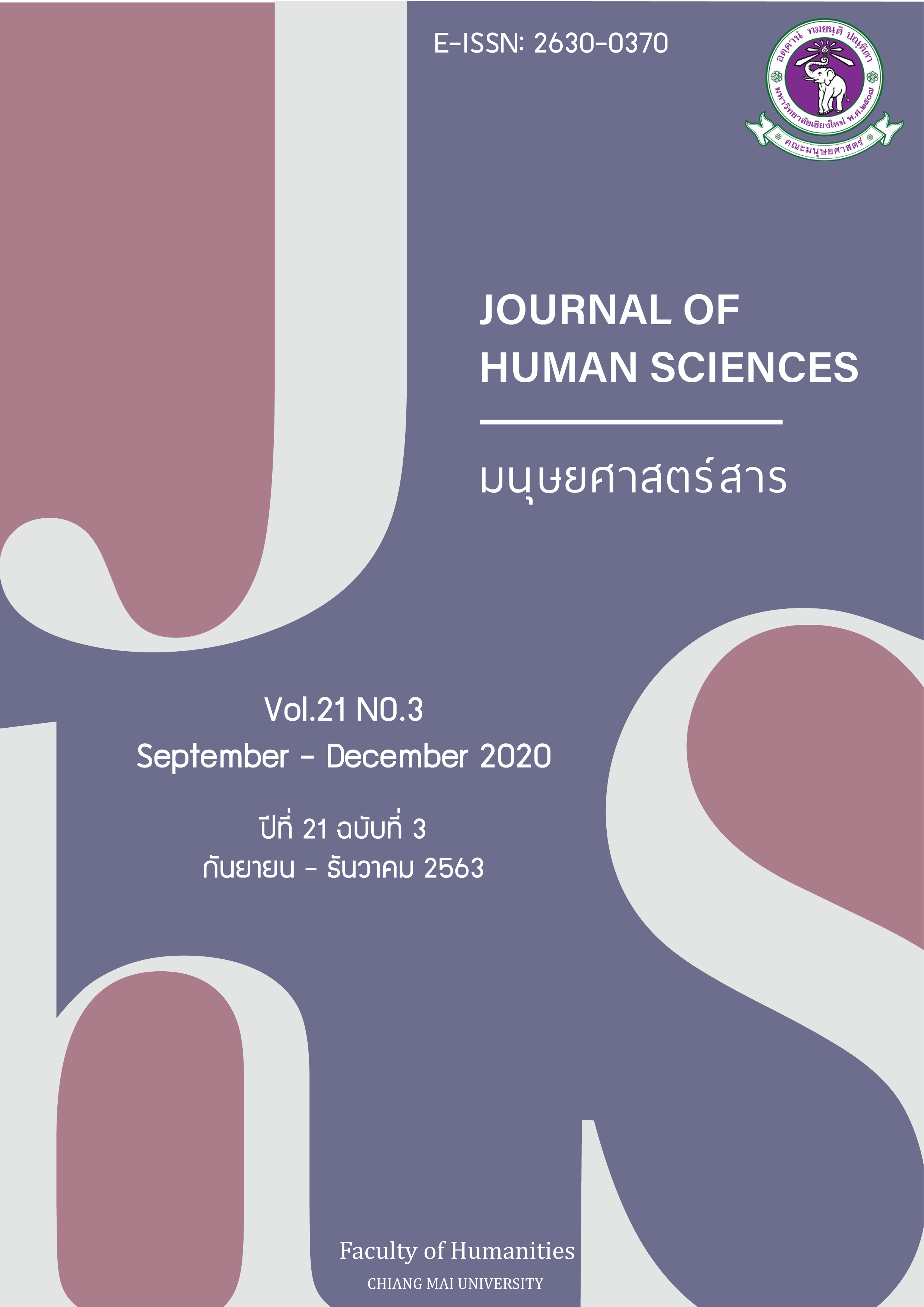วัจนลีลาด้านบุคคลสัมพันธ์และกลวิธีทางภาษา ในบทความของวารสารวิชาการเยอรมันและไทยด้านภาษาและวรรณคดี
Main Article Content
บทคัดย่อ
บทความในวารสารวิชาการเป็นงานเขียนเชิงวิชาการประเภทหนึ่งที่มีความสำคัญในบริบทของการสื่อสารทางวิชาการระหว่างนักวิชาการในแวดวงเดียวกัน รูปแบบและกลวิธีทางภาษาที่ใช้ในบทความมักเป็นผลมาจากลักษณะทางบุคคลสัมพันธ์หรือบทบาทของผู้มีส่วนร่วมในสถานการณ์การสื่อสารดังกล่าว งานวิจัยนี้จึงมีวัตถุประสงค์ที่จะศึกษาวิเคราะห์เปรียบต่างลักษณะการใช้ภาษาที่แสดงบุคคลสัมพันธ์และกลวิธีทางภาษาที่ผู้เขียนใช้ในการนำเสนอบทความในวารสารวิชาการเยอรมันและไทยด้านภาษาและวรรณคดี วิธีการศึกษาที่ใช้เป็นการวิเคราะห์ลักษณะบุคคลสัมพันธ์ตามแนวทางของ Kresta (1995) ซึ่งพัฒนาจากมุมมองของภาษาศาสตร์เชิงระบบหน้าที่ในส่วนที่เกี่ยวกับหน้าที่ด้านบุคคลสัมพันธ์ของภาษา ผลการวิจัยพบว่า ในปัจจุบัน ผู้เขียนบทความในวารสารวิชาการเยอรมันและไทยนิยมกล่าวถึงตนเองเหมือนกัน โดยผู้เขียนชาวเยอรมันมักใช้บุรุษสรรพนามเอกพจน์ บุรุษที่ 1 ich ซึ่งต่างจากขนบนิยมดั้งเดิมในวงวิชาการเยอรมัน ส่วนผู้เขียนชาวไทยจะใช้คำ ‘ผู้เขียน’ หรือ ‘ผู้วิจัย’ แทนตนเอง แม้จะมีการกล่าวถึงตนเองอย่างชัดเจน แต่ผู้เขียนบทความทั้งสองภาษาก็มีกลวิธีทางภาษาที่นิยมใช้มากที่สุดเหมือนกัน เพื่อแสดงทัศนะอย่างระมัดระวังตน นั่นคือ การใช้กริยาช่วยแสดงทัศนะเป็น hedges
Article Details
เอกสารอ้างอิง
Bhandhumedha, N. (2006). Waiyako̜nthai [Thai Grammar]. Bangkok: Faculty of Arts, Chulalongkorn University.
Breitkopf, A. (2006). Wissenschaftsstile im Vergleich: Subjektivität in deutschen und russischen Zeitschriftenartikeln der Soziologie. Freiburg: Rombach.
Busch-Lauer, I-A. (2001). Fachtexte im Kontrast: eine linguistische Analyse zu den Kommuni-kationsbereichen Medizin und Linguistik. Frankfurt: Peter Lang.
Clemen, G. (1998). Hecke in deutschen und englischen Texten der Wirtschaftskommunikation. Eine kontrastive Analyse. (Doctoral thesis, University of Siegen).
Clyne, M. (1991). Zu kulturellen Unterschieden in der Produktion und Wahrnehmung englischer und deutscher wissenschaftlicher Texte. Info DaF18, (4). 376-383.
Dudenredaktion. (eds.). (2005). Duden. Die Grammatik (7th ed). Mannheim: Duden Verlag.
Galtung, J. (1985). Struktur, Kultur und interkultureller Stil. Ein vergleichender Essay über sachsonische, teutonische, gallische und nipponische Wissenschaft. In A. Wierlacher (eds.), Das Fremde und das Eigene. Prolegomina zu einer interkulturellen Germanistik. (pp. 151-193). München: iudicium.
Graefen, G. (1997). Der wissenschaftliche Artikel: Textart und Textorganisation. Berlin: Peter Lang.
Graefen, G., & Moll, M. (2011). Wissenschaftssprache Deutsch: lesen – verstehen – schreiben. Ein Lehr- und Arbeitsbuch. Frankfurt: Peter Lang.
Graefen, G., & Thielmann, W. (2007). Der wissenschaftliche Artikel. In P. Auer & H. Baßler (eds.), Reden und Schreiben in der Wissenschaft. (pp. 67-97). Frankfurt: Campus Verlag.
Kresta, R. (1995). Realisierungsformen der Interpersonalität in vier linguistischen Fachtextsorten des Englischen und des Deutschen. Frankfurt: Peter Lang.
Martín-Martín, P. (2005). The Rhetoric of the Abstract in English and Spanish Scientific Discourse. A Cross-Cultural Genre-Analytic Approach. Frankfurt a. M. et al.: Peter Lang.
Oldenburg, A. (1997). Überlegungen zur interkulturellen Untersuchung von Wissenschaftsstilen. Fachsprache, 19. 9-16.
Prasithrathsint, A. (1989). Kham chamkatkhwam sap nai phasasatsangkhom [Definitions of Terms in Sociolinguistics]. Bangkok: Chulalongkorn University.
Ratchabanthittayasathan (2010). Photchananukrom sap phasasat (phasasatprayuk) Chabap ratchabanthittayasathan [Dictionary of Linguistic Terms. (Applied Linguistics) Royal Academy Edition]. Bangkok: Royal Institute of Thailand.
Schlömer, A. (2012). Interkulturelle Aspekte der Wissenschaftskommunikation am Beispiel der Textsorte wissenschaftlicher Aufsatz. Professional Communication and Translation Studies, 5(1-2). 48-64.
Somprayoon, S., & Somprayoon, W. (2007). Kankhian nangsư rư tamra læ botkhwam [Writing Books or Textbooks and Articles]. Bangkok: Institute of Academic Development.
Sriuranpong, W. (2015). Botkhatyo̜ nai warasanwichakan yœraman læ thai dan phasa læ wannakhadi: Kansưksa priaptang chœng phasasat kho̜khwamto̜nưang [Abstracts in German and Thai Journals of Language and Literature: A Contrastive Text Linguistic Study]. Journal of Language and Linguistics, 33(2). 25-51.
Sriuranpong, W. (2014). Botkhatyo̜ nai warasanwichakan yœraman læ thai dan phasa læ wannakhadi: Kansưksa priaptang chœng phasasat kho̜khwamto̜nưang [Abstracts in German and Thai Journals of Language and Literature: A Contrastive Text Linguistic Study]. Bangkok: Research Fund of the Faculty of Arts, Chulalongkorn University.
Steinseifer, M., Feilke, H., & Lehnen, K. (2019). Eristische Literalität. Heidelberg: Synchron.
Suwanthada, N. (2005). Kankhian phonnganwichakan læ botkhwam [Writing Academic Works and Academic Papers]. Bangkok: Sukhothai Thammathirat University.
Terasorn, S. (2012). Chak nganwichai su botkhwamwichakan Phim krung thi song [From Research to Academic Papers]. (2nd ed.). Bangkok: Chulalongkorn University.
Trumpp, E. K. (1998). Fachtextsorten Kontrastiv: Englisch-Deutsch-Französisch. Tübingen: Gunter Narr.


